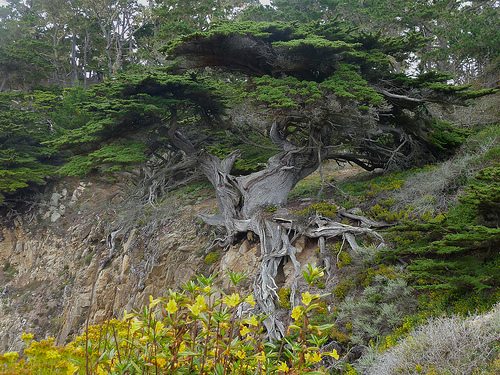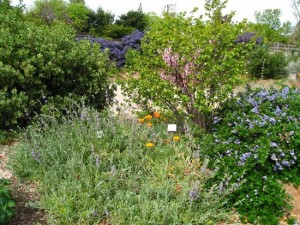Native Plants of the Southern California Coast

Southern California is not a desert. Only the area east of the mountains can correctly be characterized as a desert having plants we know as desert plants.
The coastal zones of California, west of the mountains have a Mediterranean climate, which means dry summers with brilliant sunshine and blue skies, and almost all rainfall concentrated during the mild, winter and spring, averaging 10 to 40 inches per year (worldwide average for Mediterranean climates). Snowfall is rare except at high elevations.
 Mediterranean climates occur on approximately 2% of the world’s total land, on the south and southwestern portions of a large land mass. There are 5 main areas: California, the Mediterranean Basin, Central Chile, Western Cape of South Africa, and Southwest and South Australia (which also faces West.)
Mediterranean climates occur on approximately 2% of the world’s total land, on the south and southwestern portions of a large land mass. There are 5 main areas: California, the Mediterranean Basin, Central Chile, Western Cape of South Africa, and Southwest and South Australia (which also faces West.)
Native plants of these regions are typically endemic to certain defined areas, because of climates within climates, caused by sun, shade, temperature, distance from coast, elevation, air currents, soil, and moisture. Not all native plants are drought resistant.
Plant adaptation, drought-evading tactics include: Summer-deciduous plants, bulbs store water in roots, annuals die after setting seeds, seeds spring up after fire, tap roots for rapid establishment combined with fine surface roots to catch moisture, plants springing from ground after fire, gray leaves resistant to sun, hairs on leaves to protect leave (hirsute), tough leathery leaves resist dehydration, thick succulent leaves and stems, protective waxy surface of leaves, mulch from fallen leaves.
Plant history of California:
- Much of California coastal region was covered with native bunchgrasses. Antelope (prong horns) abounded. The Indians burned off the thick chaparral in winter to make more spaces for grasses to grow and also to create pathways for themselves so they could get around through the thick growth. This was the California seen by Portola. In one area a botanist with his group described a valley covered with wild roses. Obviously this was a dry land, but not a desert! Native oaks also forested some portions.
- California poppy fields in Altadena were a landmark to Spanish galleons 30 miles distant, out to sea. At first they thought it was a hillside covered with gold.
- The Mission era was marked by an influx of Spanish priests who imported food plants and used irrigation methods learned in Spain. They saved the wild landscape but brought in certain non-native plants such as California pepper, Canary Island palm, and, from Northern California, .
- The Rancho era.
– Cattle ate and destroyed our native grasses.
– Ranchers imported European annual grasses that go brown in summer and now cover our hills
The privilege of living in San Diego, combined with the danger of fire.
- Compared to Amalfi coast where the hills burn but the houses are built of stone and all huddled together in walled, fireproof villages. We are just now beginning to learn about fire-resistant housing and gardens.
- Different types of Chaparral (Chaparral is not all alike. Each is a mix of many plants in a plant community, and these are distinguished and named for the dominant plant in each one.)
– chamise chaparral,
– coastal sage chaparral
– ceonothus chaparral,
– manzanita chapparal,
– scrub oak chapparal,
– others.
Similar plant communities or habitats in other Mediterranean climates around the world.
- Mantorral—Chile, or Espino (sparse savannah)
- Fynbos—South Africa (meaning “fine brush” or “fine bush”—proteas etc.) or Ericas (meaning heaths)
- Scrub Heath—Australia
- Maquis—Mediterranean (many types) and Garrigue (same thing but sparser and on poorer ground.)
Photo by roy.luck 


i”am going to do a project on this and it will help me out for doing searching back for me
Hills of poppies luring the explorers to shore – what a wonderful California story! You didn’t mention the padres and their mustard trail or the eucalyptus debacle – but those are well-known. Thank you for this interesting post and inspiring me to learn to identify the chaparral types.
Thanks for kind comment!